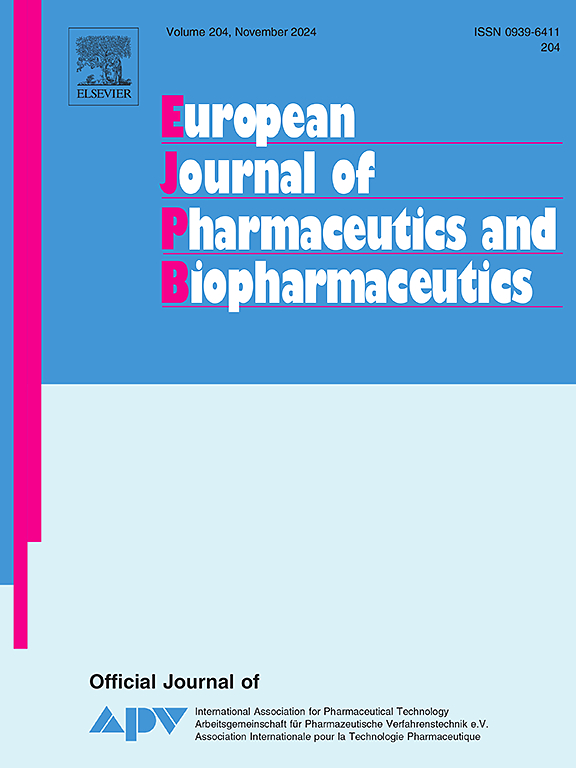将双相系统与GIS-α结合可改善低溶解度药物的体内预测
IF 4.4
2区 医学
Q1 PHARMACOLOGY & PHARMACY
European Journal of Pharmaceutics and Biopharmaceutics
Pub Date : 2025-04-23
DOI:10.1016/j.ejpb.2025.114724
引用次数: 0
摘要
胃肠模拟器alpha (GIS-α)是一种体内预测转移溶出度的方法,它模拟了pH变化和胃肠道的蠕动,这些因素是生物相关药物溶出的必要因素,特别是生物制药分类系统(BCS) II类和IV类药物。它可以用于增加对各种低溶解度药物的溶出,沉淀和过饱和的理解。但缺乏对吸收的洞察。用双相系统在GIS-α中进行实验,在空肠室中添加吸收相,增加了观察到的溶解,提高了总体的体内预测。在这项研究中,目的是评估使用GIS-α双相格式对四种代表性BCS II类药物的溶出度的改善。在空肠腔中还使用定制的双桨同时混合水缓冲液和有机层。随着水体积的增加,这个桨漂浮在有机层中,并保持水相和有机相的流体动力学。GIS-α中的双相系统与移动的双桨的结合导致非诺贝特、那那唑和塞来昔布的溶出谱增加,而不影响利托那韦的溶出谱。使用GastroPlus®将这些溶出谱纳入PBPK模型,提高了这些口服药物生物性能的可预测性。总的来说,该方法考虑了溶解和吸收,并被证明是预测低溶解度药物体内性能的有用工具。本文章由计算机程序翻译,如有差异,请以英文原文为准。

Incorporating the biphasic system to GIS-α Improves In vivo prediction for low solubility drugs
The gastrointestinal simulator alpha (GIS-α) is an in vivo predictive transfer dissolution method that mimics the pH changes and peristalsis in the gastrointestinal tract, factors that are necessary in the biorelevant dissolution of drugs especially those that are under the Biopharmaceutics Classification System (BCS) class II and IV. It can be used to provide increased understanding to the dissolution, precipitation, and supersaturation of various low-solubility drugs, but lacks insights on absorption. Conducting experiments in the GIS-α with a biphasic system to add an absorptive phase in the jejunal compartment increased the observed dissolution and improved the overall in vivo prediction. In this study, the objective was to evaluate the improvement of dissolution on four representative BCS class II drugs using the biphasic format in the GIS-α. A customized double paddle was also used in the jejunal chamber to mix the aqueous buffer and organic layer simultaneously. This paddle floats in the organic layer as the aqueous volume increases and maintains the hydrodynamics in both the aqueous and organic phases. The combination of the biphasic system in the GIS-α and the moving double paddles resulted to increased dissolution profiles of fenofibrate, danazol, and celecoxib while not affecting that of ritonavir. Incorporating these dissolution profiles in a PBPK model using GastroPlus® improved the predictability of bioperformance of those oral medicines. Overall, this methodology considers both dissolution and absorption and proves to be a useful tool in predicting the in vivo performance of low-solubility drugs.
求助全文
通过发布文献求助,成功后即可免费获取论文全文。
去求助
来源期刊
CiteScore
8.80
自引率
4.10%
发文量
211
审稿时长
36 days
期刊介绍:
The European Journal of Pharmaceutics and Biopharmaceutics provides a medium for the publication of novel, innovative and hypothesis-driven research from the areas of Pharmaceutics and Biopharmaceutics.
Topics covered include for example:
Design and development of drug delivery systems for pharmaceuticals and biopharmaceuticals (small molecules, proteins, nucleic acids)
Aspects of manufacturing process design
Biomedical aspects of drug product design
Strategies and formulations for controlled drug transport across biological barriers
Physicochemical aspects of drug product development
Novel excipients for drug product design
Drug delivery and controlled release systems for systemic and local applications
Nanomaterials for therapeutic and diagnostic purposes
Advanced therapy medicinal products
Medical devices supporting a distinct pharmacological effect.

 求助内容:
求助内容: 应助结果提醒方式:
应助结果提醒方式:


